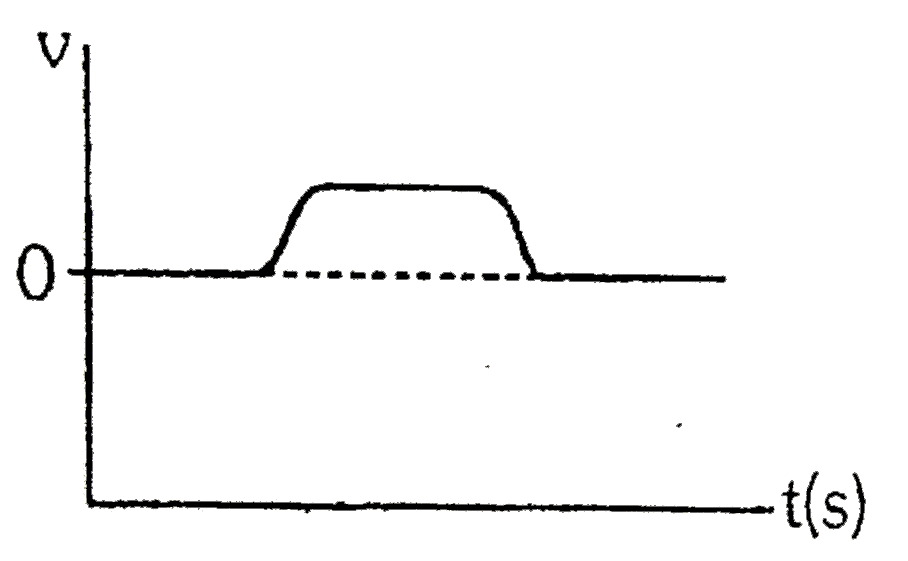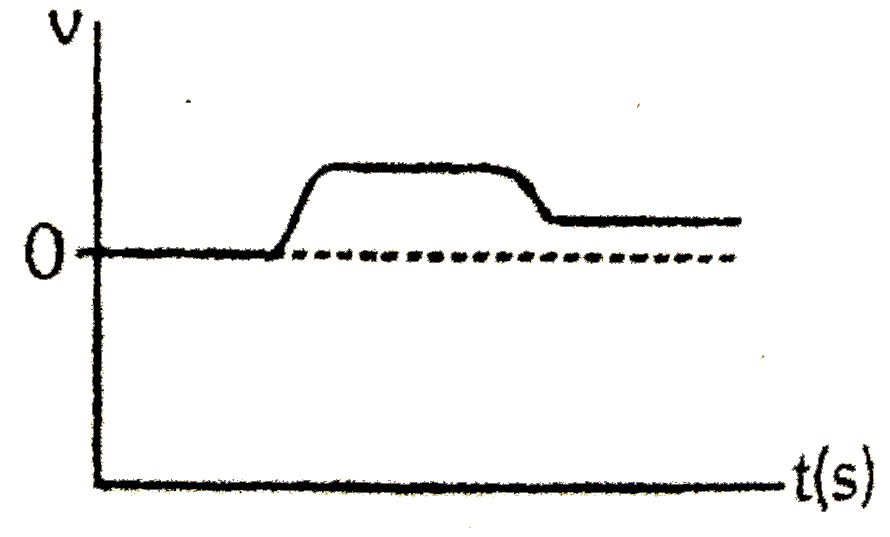Two friends are sitting in a stationary boat. At t=30s the person at the fromt tosses a sack to the person in the rear, who catches the sack 0.2s later. Which plot in figure shows the velocity of the boat as a fuction of time ? Positive velocity is forward, negative velocity is backward. Neglet any drag force on the boat from the water :-




The correct Answer is:A
Step by step video & image solution for Two friends are sitting in a stationary boat. At t = 30s the person at the fromt tosses a sack to the person in the rear, who catches the sack 0.2 s later. Which plot in figure shows the velocity of the boat as a fuction of time ? Positive velocity is forward, negative velocity is backward. Neglet any drag force on the boat from the water :- by Physics experts to help you in doubts & scoring excellent marks in Class 11 exams.
Updated on:21/07/2023Topper's Solved these Questions
- CENTRE OF MASSBOOK - ALLENCHAPTER - CENTRE OF MASSEXERCISE - EXERCISE-II
43 Videos
- CENTRE OF MASSBOOK - ALLENCHAPTER - CENTRE OF MASSEXERCISE - EXERCISE-III
42 Videos
- CENTRE OF MASSBOOK - ALLENCHAPTER - CENTRE OF MASSEXERCISE - EXERCISE-V B
19 Videos
- BASIC MATHEMATICS USED IN PHYSICS &VECTORS BOOK - ALLENCHAPTER - BASIC MATHEMATICS USED IN PHYSICS &VECTORS EXERCISE - EXERCISE-IV ASSERTION & REASON
11 Videos
- ELASTICITY, SURFACE TENSION AND FLUID MECHANICSBOOK - ALLENCHAPTER - ELASTICITY, SURFACE TENSION AND FLUID MECHANICSEXERCISE - Exercise 5 B (Integer Type Questions)
3 Videos
Similar Questions
Two persons P and Q crosses the river starting from point A on one side to exactly opposite point B on the other bank of the river. The person P crosses the river in the shortest path. The person Q crosses the river in shortest time and walks back to point B. Velocity of river is 3 kmph and speed of each boat is 5 kmph w.r.t river. If the two persons reach the point B in the same time, then the speed of walk of Q is
View SolutionAssume that you are sitting in a car at rest. You see a person in the rear view mirror of radius of curvature 2m running towards you at t=0. if person is running with velocity 5m/s and it is at 9m distance from mirror at this instant, the average velocity (in mm/sec) of image of man in first second is found to be 20x. find the value of x
View SolutionStationary wave is setup in a uniform string clamped at both the ends. Length of the string is 0.3 m.Snapshot of the string is taken the two instants one at t=0 sec and another at t=0.2 sec. These is two snapshots are shown below.

Velocity of point P (which is also the mid point of the string ) is in upward direction (take upward direction to be positive ) at t=0 sec.At the instant snapshots are taken particles are at half of their respective maximum displacement from mean position.During this time interval particles have crossed their mean position only once.Answer the following 3 questions for the qiven situation.
Velocity of travelling wave in the string is :
View SolutionStationary wave is setup in a uniform string clamped at both the ends. Length of the string is 0.3 m.Snapshot of the string is taken the two instants one at t=0 sec and another at t=0.2 sec. These is two snapshots are shown below.

Velocity of point P (which is also the mid point of the string ) is in upward direction (take upward direction to be positive ) at t=0 sec.At the instant snapshots are taken particles are at half of their respective maximum displacement from mean position.During this time interval particles have crossed their mean position only once.Answer the following 3 questions for the qiven situation.
Velocity time graph of particle at mid point of the string (i.e. particle P)
View SolutionAt t=0, the positions and velocities of two particles are as shown in the figure. They are kept on a smooth surface and being mutually attracted by gravitational force. Find the position of centre of mass at t=2s.
 .
.
View SolutionAt t=0, the positions and velocities of two particles are as shown in the figure. They are kept on a smooth surface and being mutually attracted by gravitational force. Find the position of centre of mass at t=2s.
 .
.
View SolutionA 2kg toy car can move along an x axis. Graph shows force Fx , acting on the car which being at rest at time t=0 . The velocity of the particle at t=10s is:

View SolutionOn a stationary block of mass 2kg a horizontal forces F starts acting at t=0 whose veriation with time is shown in figure .The coefficient of friction between the block and ground is 0.5 New answer the following question

Find the velocity of the at t=12s
View SolutionA circus wishes to develop a new clown act. Fig. (1) shows a diagram of the proposed setup. A clown will be shot out of a cannot with velocity v0 at a trajectory that makes an angle θ=45∘ with the ground. At this angile, the clown will travell a maximum horizontal distance. The cannot will accelerate the clown by applying a constant force of 10,000N over a very short time of 0.24s. The height above the ground at which the clown begins his trajectory is 10m.

A large hoop is to be suspended from the celling by a massless cable at just the right place so that the clown will be able to dive through it when he reaches a maximum height above the ground. After passing through the hoop he will then continue on his trajectory until arriving at the safety net. Fig (2) shows a graph of the vertical component of the clown's velocity as a function of time between the cannon and the hoop. Since the velocity depends on the mass of the particular clown performing the act, the graph shows data for serveral different masses.

The slope of the line segments plotted in figure 2 is a figure constant. Which one of the following physical quantities does this slope represent?
View SolutionDirection :
Resistive force proportional to object velocity
At low speeds, the resistive force acting on an object that is moving a viscous medium is effectively modeleld as being proportional to the object velocity. The mathematical representation of the resistive force can be expressed as
R=−bv
Where v is the velocity of the object and b is a positive constant that depends onthe properties of the medium and on the shape and dimensions of the object. The negative sign represents the fact that the resistance froce is opposite to the velocity.
Consider a sphere of mass m released frm rest in a liquid. Assuming that the only forces acting on the spheres are the resistive froce R and the weight mg, we can describe its motion using Newton's second law. though the buoyant force is also acting on the submerged object the force is constant and effect of this force be modeled by changing the apparent weight of the sphere by a constant froce, so we can ignore it here.
Thus mg−bv=mdvdt⇒dvdt=g−bmv
Solving the equation
v=mgb(1−e−bt/m)
where e=2.71 is the base of the natural logarithm
The acceleration becomes zero when the increasing resistive force eventually the weight. At this point, the object reaches its terminals speed v1 and then on it continues to move with zero acceleration
mg−bT=0
⇒mT=mgb
Hence v=vT(1−evtm)
In an experimental set-up four objects I,II,III,IV were released in same liquid. Using the data collected for the subsequent motions value of constant b were calculated. Respective data are shown in table.
ObjectIIIIIIVMass (in kg.)1234Constant bin (N-s)/m3.71.41.42.8
If an object of mass 2 kg and constant b=4N−sm has terminal speed vT in a liquid then time required to reach 0.63vT from start of the motion is :
View Solution
